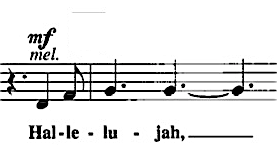| ハレルヤ |
|
|
Leonard
Cohen's song "Hallelujah" is considered one of his most
brilliant works. It was initially rejected in 1984; only after John
Cale's 1990 arrangement did the song capture the attention of the
music world. |
レナードコーエンの曲「ハレルヤ」は、彼の最も素晴らしい作品の1つと考えられています。
1984年に拒否されました。 ジョンケールの1990年の編曲後のみ、この曲は音楽界の注目を集めました。 |
|
"Hallelujah"
is a Hebrew compound word. "Hallelu" is an exhortation
for a group of people to praise someone or something. "Yah"
is short for YHWH (Yahweh or Jehovah) the creator. It is commonly
used in Hebrew and in Arabic to mean "praise to God."
In modern English, it is frequently used to express happiness and
relief that something ardently desired has happened.
|
「ハレルヤ」はヘブライ語の複合語です。
「ハレル」は、人々のグループが誰かまたは何かを称賛するように勧める言葉です。 「ヤー」はYHWH(ヤーウェまたはエホバ)で、意味はクリエイターです。
ヘブライ語とアラビア語では「神への賛美」を意味です。英語では、切望されていることが起こった時の幸福と安心を表すために使われます。 |
| Much
has been made of the symbolism in Cohen's song. Kyson Parks calls
it "a story of broken love, true love remembered and mourned,
guilt and penance, and finding peace in the vicissitude of brokenness."* |
コーエンの歌の多くは象徴性から成っています。
カイソン・パークスはそれを「壊れた愛、本当の愛を思い出し、悼み、罪悪感と悔い改め、そして壊滅の変化の中で平和を見つける物語」と呼んでいます。* |
| When
asked why he wrote "Hallelujah," Leonard Cohen said: "This
world is full of conflicts and full of things that cannot be reconciled.
But there are moments when we can… reconcile and embrace the whole
mess, and that's what I mean by 'Hallelujah.' […] The song explains
that many kinds of hallelujahs do exist, and all the perfect and broken
hallelujahs have equal value. It's a desire to affirm my faith in
life, not in some formal religious way but with enthusiasm, with emotion."** |
なぜ彼が「ハレルヤ」を書いたのかと尋ねられた時、レナードコーエンは言った:「この世界は対立と和解できないものでいっぱいです。
しかし、私たちができる瞬間があります...混乱全体を和解させて受け入れるのです。それが私が「ハレルヤ」とはどういう意味かを表しています。[…]この歌は、多くの種類のハレルヤが存在し、すべての完璧なハレルヤと壊れたハレルヤが同じ価値を持つことを説明しています。
私の人生への信仰を、何らかの正式な宗教的方法ではなく、熱意と感情をもって肯定することを望んでいます。」** |
| This painting attempts to capture that moment when the cry of hallelujah erupts from the heart without regard for thought. The first five red crowned cranes from the left may evince the notes of the first "hallelujah" in Leonard Cohen's refrain. Perhaps the sixth red crowned crane is bowing in submission to all the broken and the perfect hallelujahs. | この絵は、ハレルヤが心から噴出する瞬間をとらえようとしています。左から最初の5つのタンチョウは、レナードコーエンのリフレインの最初の5つの音符を示しています。
6番目のタンチョウはすべての壊れたハレルヤと完璧なハレルヤにお辞儀をします。 *友達の宇佐美ゆきさんが私の(Google 翻訳からの)日本語の一部の編集しました。私は残りの奇妙な日本語の分に対して責任があります。 |
 |
| *The Meaning and History of the
Song "Hallelujah," by Leonard Cohen https://spinditty.com/genres/The-Origin-and-History-of-the-Song-Hallelujah **Leonard Cohen, Hallelujah: the meaning of the lyrics https://auralcrave.com/en/2020/01/19/leonard-cohen-hallelujah-the-meaning-of-the-lyrics/ |